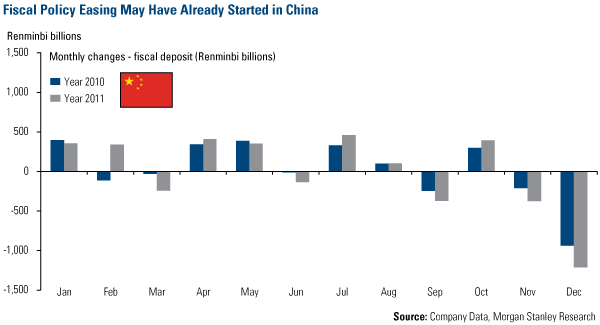Emerging Markets Radar (January 23, 2012)
Strengths
- China’s fourth quarter GDP growth was 8.9 percent, better than the expected 8.7 percent.
- China’s December retail sales were up 18.1 percent, better than the estimated 17.2 percent. For 2011 it was up 17.1 percent year-over-year, showing strong consumption demand.
- Disposable income for urban residents grew 14.1 percent in 2011, and 8.4 percent. In 2011, China’s urban population increased by 21 million to 690.79 million at the end of last year. For the first time in China’s history, urban population has exceeded the rural population, the National Bureau of Statistics said.
- December industrial production was up 12.8 percent, higher than the estimate os 12.3 percent. Industrial production grew 13.9 percent in 2011, better than estimated.
- HSBC China’s Flash Purchasing Manager’s Index (PMI) is 48.8 for January, higher than 48.7 in December last year. PMI below 50 indicates manufacturing activities are in contraction. The HSBC Flash PMI is a survey among small and medium sized enterprises (SME) in China, which means it reflects part of the industrial activities in China. In China, as in many other countries, SMEs are mostly disadvantaged for financing. We hope Wen Jiabao’s SME loan policies can eventually help resume their growth.
- Chinese bank lending in the first quarter may exceed the 2.26 trillion yuan from a year earlier.
- China’s central bank, PBOC, injected Rmb 183 billion into the system via reverse repos on Wednesday, and Rmb 200 billion again on Thursday while urging more lending.
- China is said to consider relaxing capital requirements for banks. The China Banking Regulatory Commission is delaying implementing the most stringent capital adequacy ratios and may lower risk weightings for loans to small businessmen and companies.
- The Chinese banks totally issued Rmb 16.5 trillion worth of wealth management products, of which listed companies spent Rmb 30.4 billion buying these bank products. This was one reason that deposit growth was slowing.
- China’s National Social Security Fund has won approval to invest Rmb 100 billion from local pensions in stocks and bonds.
- Online advertising spending in China will rise 33 percent to Rmb 63.8 billion ($10 billion) this year from last year, the South China Morning Post said citing a broker report.
- Moody’s just upgraded Indonesia’s sovereign credit to investment grade after Fitch did the same in December last year. This will reduce borrowing costs for corporations and help stabilize currency.
- The Philippines’ central bank cut its benchmark rate by 25 basis points down to 4.25 percent. It was the first rate cut since July 2009. The Philippines runs an independent monetary policy since its economy is mostly domestic. Philippines overseas remittance rose 10.6 percent year-over-year in November to $1.78 billion, the biggest increase in three months.
- Thailand’s exports dropped 2 percent on a year-over-year basis in December as factories and supply chains began to recover from the flooding. The result was much higher than expectations for a 10 percent drop and a significant improvement from November’s 12.4 percent decline.
- Malaysia’s CPI rose 3 percent year-over-year in December, slowing to a nine-month low.
- Government statistics show that Colombia’s industrial production rose 6.5 percent in November from a year earlier.
- Indonesia received its second investment-grade rating from Moody’s this week, raising the country’s sovereign credit rating to Baa3. A month prior, Fitch had upgraded Indonesia’s credit rating as well.
Weaknesses
- Taiwan’s December export order declined 0.7 percent, for the first time since mid 2009.
- Due to housing market tightening and postponement of high speed rail projects by the government, China fixed asset investment still grew 23.8 percent, lower than 2010 and providing some clue to 2012’s slower investment growth. CITIC Securities predicts housing investment will decline in the first half of this year before the government lifts its control on the real estate market.
- China’s December home prices posted their worst performance last year, with only two of the 70 cities tracked posting gains, as the government reintegrated its plans to maintain housing curbs. In fact, sales transactions dropped sharply, between 15 to 20 percent on average, but the price drop was still very mild.
- China’s foreign direct investment declined 12.7 percent in December after a 9.8 percent drop in November on a year-over-year basis, a further reason for moderate money supply growth.
Opportunities
- The fiscal deposit decrease since September, particularly in December of last year, indicated that the Chinese central government had started fiscal expansion to fine-tune the economy. Evidence such as improved PMI and industrial production in December proved the government has changed its policy focus to supporting growth from economic adjustment (tightening).

- Barclay’s Capital reported that China may allow its local pension funds to be invested in its stock market in the first quarter of this year, according to the China Securities Journal. The report said that a province in southern China was approved to transfer 100 billion Yuan of local pension funds to the National Council for Social Security Fund (NCSSF) for operation. In view of the NCSSF's assets structure, about 30 percent to 40 percent of such capital will be invested in the stock market.
- A BCA credit cycle lead indicator is giving a positive signal for European equities and risk assets in the first half of 2012. Shaded areas in the chart below denote periods of anticipated market weakness, while clear bars forecast market strength based on an upturn in the global credit conditions six months previously. With the second 3-year LTRO tranche due in February, the ECB’s balance sheet is expected to expand by 1 trillion euro, amount almost identical to the U.S. Fed’s balance sheet expansion of $1.4 trillion in 2008/09.

Threats
- Two major sets of economic data that can continue to decline are GDP growth and property investment in the first half. Before the economy touches its lowest growth rate, hopefully by the middle of the year, the market may have to adapt to a lot of bad news in the property market, such as a sales contraction and sharp price fall.
- A number of upcoming important economic data will be released next week, including Turkey’s monetary policy decision, Poland’s 2011 GDP data, and Russia will report December industrial production.
- The World Bank warned on Tuesday that developing countries should brace for a growth slowdown stemming partly from Europe’s debt woes. Furthermore, the bank also warned that political tensions in the Middle East and North Africa could disrupt oil supplies and add another blow to global prospects. The World Bank cut its outlook for global growth in 2012 to 2.5 percent and 3.1 percent in 2013, down from 3.6 percent for both years.












